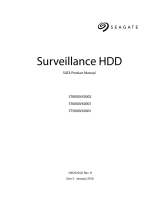
Seagate Desktop HDD Product Manual, Rev. D (Draft 6) 15
www.seagate.com Drive Specifications
2.12 Warranty
To determine the warranty for a specific drive, use a web browser to access the following web page:
http://www.seagate.com/support/warranty-and-replacements/
From this page, click on “Is my Drive under Warranty”. Users will be asked to provide the drive serial number, model number (or part
number) and country of purchase. The system will display the warranty information for the drive.
2.12.1 Storage
Maximum storage periods are 180 days within original unopened Seagate shipping package or 60 days unpackaged within the defined
non-operating limits (refer to environmental section in this manual). Storage can be extended to 1 year packaged or unpackaged under
optimal environmental conditions (25°C, <40% relative humidity non-condensing, and non-corrosive environment). During any storage
period the drive non-operational temperature, humidity, wet bulb, atmospheric conditions, shock, vibration, magnetic and electrical
field specifications should be followed.
2.13 Agency certification
2.13.1 Safety certification
These products are certified to meet the requirements of UL60950-1, CSA60950-1 and EN60950 and so marked as to the certify agency.
2.13.2 Electromagnetic compatibility
Hard drives that display the CE mark comply with the European Union (EU) requirements specified in the Electromagnetic Compatibility
Directive (2004/108/EC) as put into place 20 July 2007. Testing is performed to the levels specified by the product standards for
Information Technology Equipment (ITE). Emission levels are defined by EN 55022, Class B and the immunity levels are defined by EN
55024.
Drives are tested in representative end-user systems. Although CE-marked Seagate drives comply with the directives when used in the
test systems, we cannot guarantee that all systems will comply with the directives. The drive is designed for operation inside a properly
designed enclosure, with properly shielded I/O cable (if necessary) and terminators on all unused I/O ports. Computer manufacturers
and system integrators should confirm EMC compliance and provide CE marking for their products.
Korean RRA
If these drives have the Korean Communications Commission (KCC) logo, they comply with paragraph 1 of Article 11 of the
Electromagnetic Compatibility control Regulation and meet the Electromagnetic Compatibility (EMC) Framework requirements of the
Radio Research Agency (RRA) Communications Commission, Republic of Korea.
These drives have been tested and comply with the Electromagnetic Interference/Electromagnetic Susceptibility (EMI/EMS) for Class B
products. Drives are tested in a representative, end-user system by a Korean-recognized lab.
Australian RCM Mark
If these models have the RCM marking, they comply with the Australia/New Zealand Standard AS/NZ CISPR22 and meet the
Electromagnetic Compatibility (EMC) Framework requirements of the Australian Communication and Media Authority (ACMA).
2.13.3 FCC verification
These drives are intended to be contained solely within a personal computer or similar enclosure (not attached as an external device). As
such, each drive is considered to be a subassembly even when it is individually marketed to the customer. As a subassembly, no Federal
Communications Commission verification or certification of the device is required.
Seagate has tested this device in enclosures as described above to ensure that the total assembly (enclosure, disk drive, motherboard,
power supply, etc.) does comply with the limits for a Class B computing device, pursuant to Subpart J, Part 15 of the FCC rules. Operation
with non-certified assemblies is likely to result in interference to radio and television reception.
Radio and television interference. This equipment generates and uses radio frequency energy and if not installed and used in strict
accordance with the manufacturer’s instructions, may cause interference to radio and television reception.
This equipment is designed to provide reasonable protection against such interference in a residential installation. However, there is no
guarantee that interference will not occur in a particular installation. If this equipment does cause interference to radio or television,
which can be determined by turning the equipment on and off, users are encouraged to try one or more of the following corrective
measures:
• Reorient the receiving antenna.
• Move the device to one side or the other of the radio or TV.
• Move the device farther away from the radio or TV.
• Plug the computer into a different outlet so that the receiver and computer are on different branch outlets.
If necessary, users should consult the dealer or an experienced radio/television technician for additional suggestions. Users may find
helpful the following booklet prepared by the Federal Communications Commission: How to Identify and Resolve Radio-Television
Interference Problems. This booklet is available from the Superintendent of Documents, U.S. Government Printing Office, Washington, DC
20402. Refer to publication number 004-000-00345-4.





















